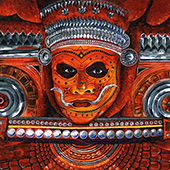In the past, low-caste individuals were prohibited from entering temples that were primarily managed by orthodox upper-caste individuals. Therefore, the disadvantaged people worshipped various sorts of important deities to support their beliefs and their way of life. They built private or communal shrine houses called ‘Kaavu’, outdoor gathering places, or locations specifically designated for worshipping these gods. High-caste individuals, such as Brahmins, may attend a Theyyam performance and seek blessings from Theyyam along with everyone else, but the distinction between temple devotion and Theyyam performances was evident.

(Image source)
Beauty of ‘Kaavu’ is that it is in the middle of nature. The lush, untamed trees and vegetation that surround ‘Kaavu’ add to its beauty and demonstrate how closely connected people were to nature.

(Image source)

Animal sacrifice in kaavu (Image source)
One sign of this is the frequent inclusion of an animal sacrifice typically a cock and alcohol consumption by the performer in a Theyyam. These customs are accepted in Indian rural shrines all over the country, but they are forbidden in orthodox Keralan temples.


